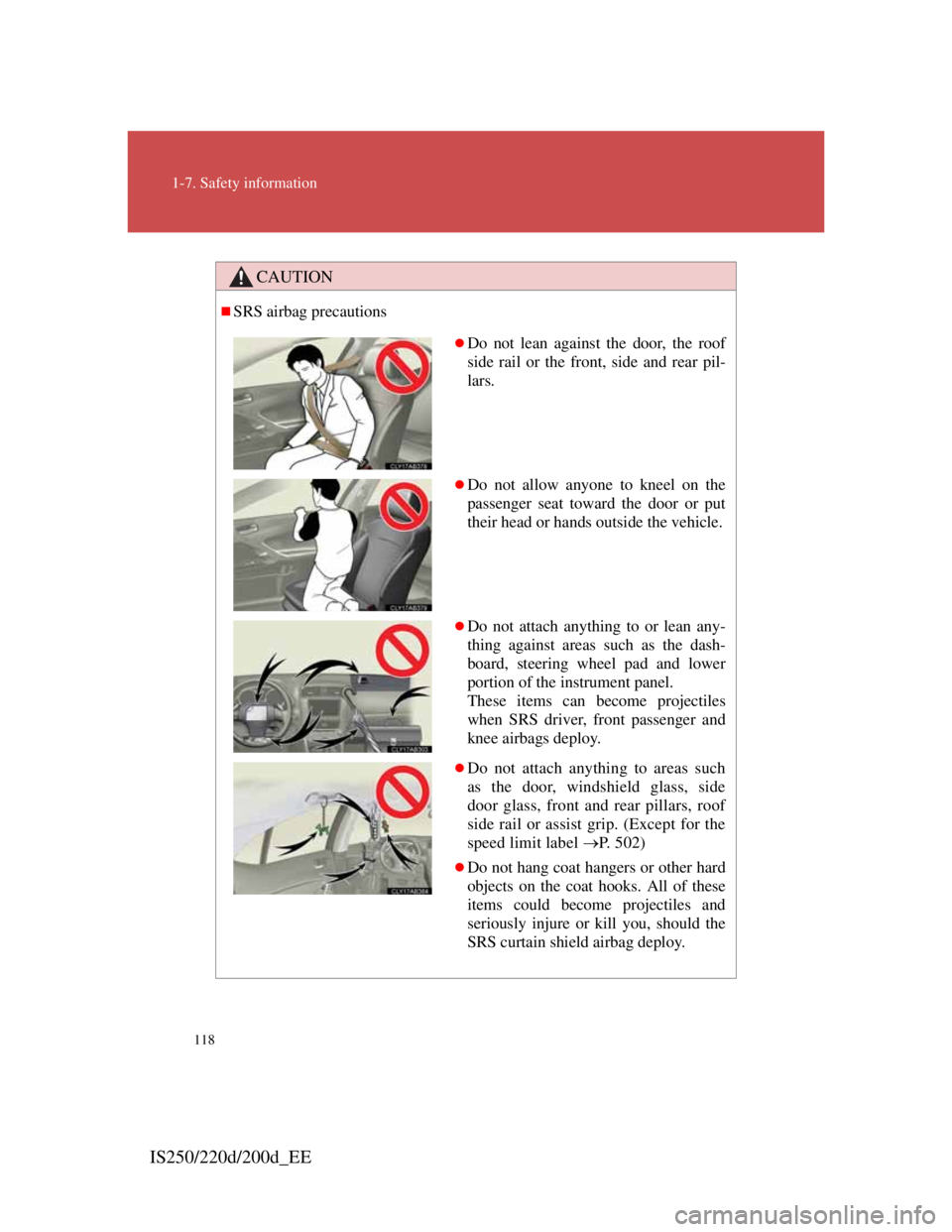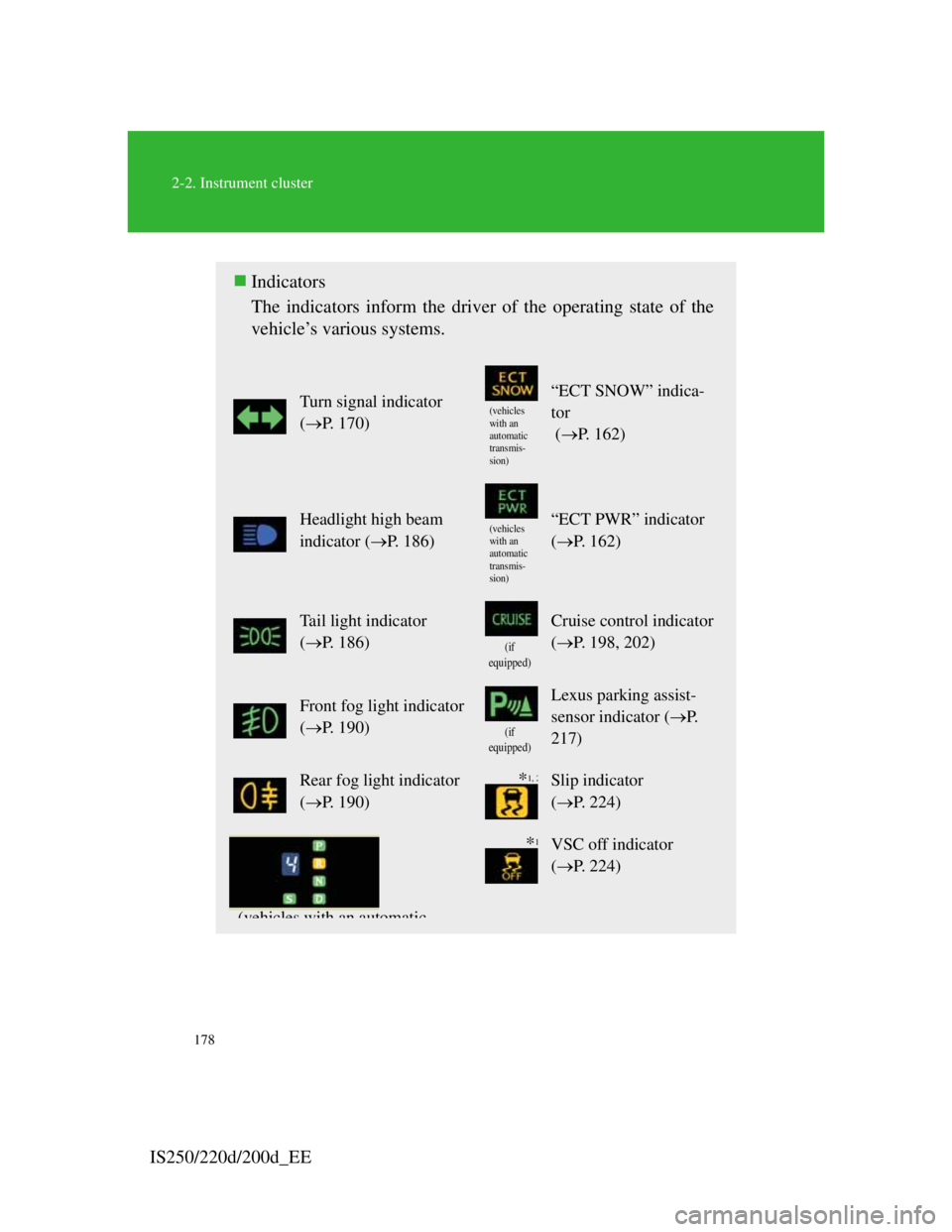head Lexus IS220d 2011 Owner's Guide
[x] Cancel search | Manufacturer: LEXUS, Model Year: 2011, Model line: IS220d, Model: Lexus IS220d 2011Pages: 609, PDF Size: 14.63 MB
Page 118 of 609

110
1-7. Safety information
IS250/220d/200d_EE
SRS airbags
The SRS airbags inflate when the vehicle is subjected to certain types
of severe impacts that may cause significant injury to the occupants.
They work together with the seat belts to help reduce the risk of death
or serious injury.
SRS front airbags
SRS driver airbag/front passenger airbag
Can help protect the head and chest of the driver and front
passenger from impact with interior components.
SRS knee airbags
Can help provide driver and front passenger protection.
SRS side and curtain shield airbags
SRS side airbags
Can help protect the torso of the front seat occupants.
SRS curtain shield airbags
Can help protect primarily the head of outside occupants.
Page 124 of 609

116
1-7. Safety information
IS250/220d/200d_EE
CAUTION
SRS airbag precautions
Observe the following precautions regarding the airbags.
Failure to do so may cause death or serious injury.
The driver and all passengers in the vehicle must wear their seat belts
properly.
The SRS airbags are supplemental devices to be used with the seat belts.
The SRS driver airbag deploys with considerable force, and can cause
death or serious injury especially if the driver is very close to the airbag.
Since the risk zone for driver airbag is the first 50 - 75 mm (2 - 3 in.) of
inflation, placing yourself 250 mm (10 in.) from your driver airbag pro-
vides you with a clear margin of safety. This distance is measured from
the center of the steering wheel to your breastbone. If you sit less than 250
mm (10 in.) away now, you can change your driving position in several
ways:
• Move your seat to the rear as far as you can while still reaching the
pedals comfortably.
• Slightly recline the back of the seat.
Although vehicle designs vary, many drivers can achieve the 250 mm
(10 in.) distance, even with the driver seat all the way forward, simply
by reclining the back of the seat somewhat. If reclining the back of
your seat makes it hard to see the road, raise yourself by using a firm,
non-slippery cushion, or raise the seat if your vehicle has that feature.
• If your steering wheel is adjustable, tilt it downward. This points the
airbag toward your chest instead of your head and neck.
The seat should be adjusted as recommended above, while still maintain-
ing control of the foot pedals, steering wheel, and your view of the instru-
ment panel controls.
Page 126 of 609

118
1-7. Safety information
IS250/220d/200d_EE
CAUTION
SRS airbag precautions
Do not lean against the door, the roof
side rail or the front, side and rear pil-
lars.
Do not allow anyone to kneel on the
passenger seat toward the door or put
their head or hands outside the vehicle.
Do not attach anything to or lean any-
thing against areas such as the dash-
board, steering wheel pad and lower
portion of the instrument panel.
These items can become projectiles
when SRS driver, front passenger and
knee airbags deploy.
Do not attach anything to areas such
as the door, windshield glass, side
door glass, front and rear pillars, roof
side rail or assist grip. (Except for the
speed limit label P. 502)
Do not hang coat hangers or other hard
objects on the coat hooks. All of these
items could become projectiles and
seriously injure or kill you, should the
SRS curtain shield airbag deploy.
Page 137 of 609

129
1
1-7. Safety information
Before driving
IS250/220d/200d_EE
CAUTION
Child restraint precautions
Never use a rear-facing child restraint system on the front passenger seat
when the airbag manual on-off switch is on. (P. 140)
In the event of an accident, the force of the rapid inflation of the front pas-
senger airbag can cause death or serious injury to the child.
A forward-facing child restraint system may be installed on the front pas-
senger seat only when it is unavoidable. Always move the seat as far back
as possible, because the front passenger airbag could inflate with consid-
erable speed and force. Otherwise, the child may be killed or seriously
injured.
Do not allow the child to lean his/her head or any part of his/her body
against the door or the area of the seat, front pillar, rear pillar or roof side
rail from which the side airbags or curtain shield airbags deploy even if
the child is seated in the child restraint system. It is dangerous if the side
airbags and curtain shield airbags inflate, and the impact could cause
death or serious injury to the child.
Make sure you have complied with all installation instructions provided
by the child restraint manufacturer and that the system is properly
secured. If it is not secured properly, it may cause death or serious injury
to the child in the event of a sudden stop, sudden swerve or an accident.
When children are in the vehicle
Do not allow children to play with the seat belt. If the seat belt becomes
twisted around a child’s neck, it may lead to choking or other serious inju-
ries that could result in death.
If this occurs and the buckle cannot be unfastened, scissors should be used
to cut the belt.
When the child restraint system is not in use
Keep the child restraint system properly secured on the seat even if it is
not in use. Do not store the restraint unsecured in the passenger compart-
ment.
If it is necessary to detach the child restraint system, remove it from the
vehicle or store it securely in the trunk. This will prevent it from injuring
passengers in the event of a sudden stop, sudden swerve or accident.
Page 142 of 609

134
1-7. Safety information
IS250/220d/200d_EE
Installation with ISOFIX rigid anchors (ISOFIX child restraint sys-
tem)
Flip the cover, and latch the
buckles onto the exclusive fix-
ing bars.
If the child restraint has a top
strap, the top strap should be
latched onto the anchor bracket.
Child restraint systems with a top strap
Secure the child restraint using
a seat belt or ISOFIX rigid
anchors and lock the head
restraint in place at the original
position.
STEP1
Page 147 of 609

139
1
1-7. Safety information
Before driving
IS250/220d/200d_EE
CAUTION
When installing a child restraint system
Make sure the outside rear seat head restraints are not in the folded posi-
tion.
Ensure that the belt and tab are securely locked and the seat belt is not
twisted.
Push and pull the child seat from side to side and forward to be sure it is
secure.
Follow all installation instructions provided by the child restraint system
manufacturer.
To correctly attach a child restraint system to the anchors
When using the lower anchors, be sure that there are no foreign objects
around the anchors and that the seat belt is not caught behind the child
restraint. Make sure the child restraint system is securely attached, or it may
cause death or serious injury to the child or other passengers in the event of
a sudden stop, sudden swerve or accident.
Page 150 of 609

2When driving
141
2-1. Driving procedures
Driving the vehicle........... 142
Engine (ignition) switch... 153
Automatic transmission ... 158
Manual transmission ........ 165
Turn signal lever .............. 167
Parking brake ................... 168
Horn ................................. 170
2-2. Instrument cluster
Gauges and meters ........... 171
Indicators and warning
lights .............................. 177
Multi-information display 1812-3. Operating the lights and wind-
shield wipers
Headlight switch .............. 186
Fog light switch ............... 190
Windshield wipers and
washer ............................ 191
Headlight cleaner switch . 197
2-4. Using other driving
systems
Cruise control .................. 198
Dynamic radar cruise
control ............................ 202
Lexus parking
assist-sensor ................... 217
Driving assist systems ..... 223
PCS (Pre-Crash Safety
system)........................... 229
2-5. Driving information
Cargo and luggage ........... 237
Winter driving tips ........... 239
Trailer towing .................. 242
Page 156 of 609

147
2-1. Driving procedures
2
When driving
IS250/220d/200d_EE
CAUTION
On vehicles with an automatic transmission, do not shift the shift lever to
P while the vehicle is moving.
Doing so can damage the transmission and may result in a loss of vehicle
control.
Do not shift the shift lever to R while the vehicle is moving forward.
Doing so can damage the transmission and may result in a loss of vehicle
control.
Do not shift the shift lever to D (vehicles with an automatic transmission)
or 1 (vehicles with a manual transmission) while the vehicle is moving
backward.
Doing so can damage the transmission and may result in a loss of vehicle
control.
Moving the shift lever to N while the vehicle is moving will disengage the
engine from the transmission. Engine braking is not available when N is
selected.
During normal driving, do not turn off the engine. Turning the engine off
while driving will not cause loss of steering or braking control, but the
power assist to these systems will be lost. This will make it more difficult
to steer and brake, so you should pull over and stop the vehicle as soon as
it is safe to do so.
However, in the event of an emergency, such as if it becomes impossible
to stop the vehicle in the normal way: P. 5 3 1
Use engine braking (downshift) to maintain a safe speed when driving
down a steep hill.
Using the brakes continuously may cause the brakes to overheat and lose
effectiveness. (P. 161)
When stopped on an inclined surface, use the brake pedal and parking
brake to prevent the vehicle from rolling backward or forward and causing
an accident.
Do not adjust the position of the steering wheel, the seat, or the inside or
outside rear view mirrors while driving.
Doing so may result in a loss of vehicle control that can cause accidents
that may result in death or serious injury.
Always check that all passengers' arms, heads or other parts of their bod-
ies are not outside the vehicle, as this may result in death or serious injury.
Page 190 of 609

178
2-2. Instrument cluster
IS250/220d/200d_EE
Indicators
The indicators inform the driver of the operating state of the
vehicle’s various systems.
Turn signal indicator
(P. 170)(vehicles
with an
automatic
transmis-
sion)
“ECT SNOW” indica-
tor
(P. 162)
Headlight high beam
indicator (P. 186)(vehicles
with an
automatic
transmis-
sion)“ECT PWR” indicator
(P. 162)
Tail light indicator
(P. 186)
(if
equipped)
Cruise control indicator
(P. 198, 202)
Front fog light indicator
(P. 190)
(if
equipped)
Lexus parking assist-
sensor indicator (P.
217)
Rear fog light indicator
(P. 190)Slip indicator
(P. 224)
(vehicles with an automatic
VSC off indicator
(P. 224)
*1, 2
*1
Page 198 of 609

186
IS250/220d/200d_EE
2-3. Operating the lights and windshield wipers
Headlight switch
Turning on the high beam headlights
With the headlights on, push
the lever forward to turn on
the high beams.
Pull the lever back to the center
position to turn the high beams
off.
Pull the lever toward you to
turn on the high beams.
Release to turn them off. You
can flash the high beams with
the headlights on or off.
The headlights can be operated manually or automatically.
Off
The front position,
tail, license plate
and instrument
panel lights turn on.
The headlights and
all lights listed
above turn on.
The headlights and
front position lights
turn on and off auto-
matically
(when the
“ENGINE START
STOP” switch is in
IGNITION ON